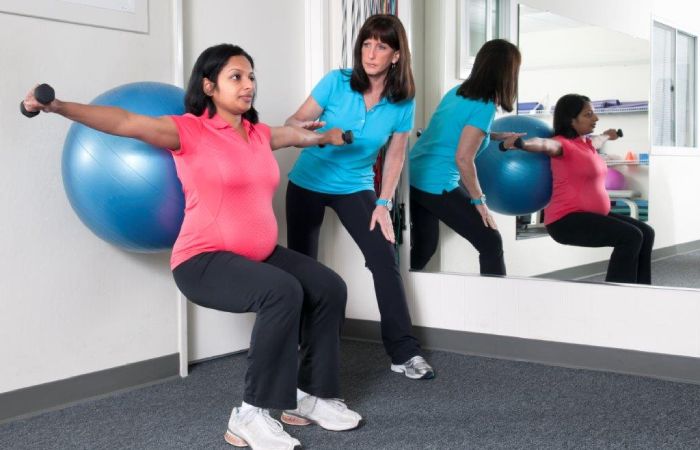 |
| Pelvic girdle pain during and after pregnancy |
 |
|

By - Namrata Gupta
Functional Manual Therapist at VARDĀN
|
|
Pelvic girdle pain (PGP) is a common occurrence in India among women. It is characterized by pain in the
front part of pelvis and/or sides of the pelvis or the rear part of the pelvis. According to research, 1 in
every 2 pregnant women experience pelvic pain at some stage of their pregnancy. In most cases, women
recover after pregnancy within 1-3 months. However, studies have demonstrated that recovery of PGP is
often incomplete and may persist for years after childbirth. Furthermore, 10-20% of women with chronic
low back pain have claimed that the initial appearance of their pain was in connection with pregnancy.
|
|
|
| Causes Of PGP During Pregnancy |
|
There are certain proposed causes of PGP during/after pregnancy, some of which are as follows:
-
Placenta releases a hormone called RELAXIN from the fourth month onwards of pregnancy. This
hormone relaxes the ligaments that hold the bones of the pelvis together and makes it easier for
the head of the baby to pass through during childbirth. As a result of relaxed ligament,
movement of bones becomes less controlled. This further increases the stress on surrounding
muscles.
-
POSTURAL changes during pregnancy are another reason for pelvic pain/discomfort. As the size
of the belly grows, the body's center of gravity changes and the lumbar arch becomes more
pronounced. This in turn increases the workload on surrounding ligaments and muscles.
-
MODE OF DELIVERY i.e. c-section vs vaginal delivery: Patients with PGP during pregnancy who
had c-section were more likely to experience persistent pain 6 months after the delivery as
compared to patients who delivered vaginally, says research. If there are no medical reasons for
c-section, findings suggest that vaginal delivery is the safest option for women presenting with
severe PGP.
|
|
|
| Types of PGP |
| SYMPHYSIS PUBIS DYSFUNCTION (SPD) |
|
Pelvic girdle is formed by two hip bones at the sides and
one triangular bone at the center of back. The two hip bones join in the front to form a joint
called symphysis pubis. Pain at symphysis pubis is reported by 31.7% of pregnant women.
Signs & symptoms:
- Pain may or may not radiate/refer to lower abdomen, back, groin, perineum, thigh
and/or leg.
- Pain with transition movements like lying to getting up, sitting to standing, using stairs,
prolonged walking, weight bearing on one leg.
- Pain is relieved with rest.
- Click/snapping/grinding sound at symphysis pubis.
- Dyspareunia
- Occasional difficulty in voiding urine.
|
|
|
| Sacroiliac (SI) joint pain |
|
SI joint is present between sacrum (in middle) and hip bone (on sides). It is the most common of all types of PGP, usually associated with symphysis pubis dysfunction.
Signs & Symptoms:
- Radiate to back of thigh or side of thigh.
- Tenderness at SI joint one side more than other.
- Worsened by prolonged sustained posture.
- Catching sensation in leg while walking.
- Characterized by positive pelvic pain provocative tests.
- In severe form can cause limp while walking.
- PGP tends to be more severe with subsequent pregnancies.
|
|
|
| Round Ligament Pain |
|
There are two round ligaments pelvis, one on either side of uterus. As
the uterus grows during pregnancy, the round ligaments stretch and thicken to accommodate
and support it. These changes cause occasional spasm-like pains that are uncomfortable but
generally harmless. It usually starts deep inside groin and moves upward and outward on either
side to hips.
Signs & Symptoms:
- Round ligament pain is felt as a short, sharp or stabbing pain during sudden change of
position, such as getting out of bed or a chair, roll over in bed. May also be felt while
coughing.
-
Dull ache after a particularly active day, after prolonged walking or doing some other
physical activity.
-
Any abdominal pain during pregnancy which continues after rest should be consulted with health care provider.
|
|
|
| Hip Joint Pain |
|
|
It is more common during the third trimester of pregnancy, usually involved side is
the side towards which the baby is present.
|
|
|
| Sciatica |
|
|
Due to increased size of uterus, there is increased pressure on nerves resulting in
symptoms such as pain and/or numbness, tingling along the distribution of nerves.
|
|
|
| Precautions To Be Taken |
|
- Avoid prolonged postures: eg take a break from sitting or standing after every 20 mins.
- Use good body biomechanics during sitting, bending, sit to stand or while exercising.
- Support the belly with both hands underneath during coughing/sneezing/laughing/transitions, like sit to stand
- Support the belly when lying on sides, also add a pillow between the knees.
- Be as active as possible within the pain limits.
- Avoid activities that increase pain, eg lifting.
|
|
|
| Treatment Options |
|
- Exercise therapy to gain initiation, strength and motor control of core muscle & pelvic floor
muscle group.
- Manual therapy to mobilize and/or stabilize the joints.
- Pelvic support belts.
- Ice Packs /heat packs to ease pain.
|
|
|
 |
| FMTTM Approach To PGP During Pregnancy |
|
|
FMTTM is a comprehensive system of evaluation and treatment through hands-on techniques. This
approach is based on three pillars: mechanical capacity, neuromuscular capacity and motor control.
Evaluation of the patient based on these pillars not only ensures assessment of the pain but also helps to
find out the cause of pain. This in simple terms means that not only joints are mobilized but also
provided with neuromuscular and motor control, so that changes made are maintained. Patient
education regarding an exercise program and proper body biomechanics which is customized according
to patient needs and goals, is also an important aspect of plan of care.
|
|
|
 |
| |
Our Client Speak
I was introduced to Vardan in 2019. Hesitantly, I started treatment here for my back under Namrata's guidance. Over a few sessions, I not only gained confidence but the continued exercise regime recommended proved very useful.
Then in 2021 I came back with a severe shoulder injury that I encountered in 2020. But COVID had kept me away from Delhi. I did guided exercises, again with Namrata over video sessions which helped. But the physical therapy with Namrata has been amazing. It took a while but her patience and understanding of what the body can take and where to push, has been phenomenal. In fact, she has taught me a lot about anatomy and muscles and their function.
I am today , a devout advocate of FMT and of it's application to corrective and preventive health. The diagnosis of the source of the problem has also been very correct; an extremely important part of treatment. My deepest thanks to Vardan and the very polite and helpful managers and of course, the therapists. In my case, Namrata.
- Varsha Bedi
|
|
|
 |
 |
| |
|
FOR MORE INFORMATION
Please call 011-43580720-22, 8:30 AM to 6:30 PM
Monday to Saturday
You may also contact our team on
+91-9971112446, +91-9910955500, +91-9810306730, +91-9910855500
Email: vardan@timesgroup.com | Web: www.vardan.in
Address: 16-A, Ring Road, Lajpat Nagar- IV, New Delhi 110024
A Functional Manual Therapist is also available in Gurugram & Noida
|
|
 |
|
|
|







